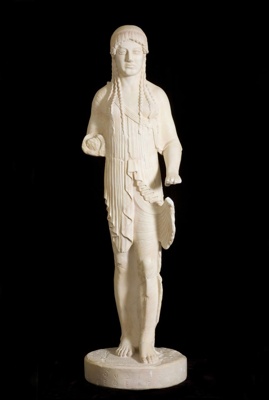< Collection search
< Collection highlights
From:UC Teece Museum of Classical Antiquities
Name/TitleEuthydikos Kore
About this objectThis is a plaster cast copy of original artifact excavated in several parts from the Acropolis in Athens between 1882 – 1887. The Euthydikos kore was probably a dedicatory statue erected on the Acropolis and is thought to be part of the ritually buried debris from the destruction of the Acropolis after the Persian invasion of Athens in 480 BC. Today the statue is preserved in two parts, one with the upper body and the other with the legs, plinth and base she stands on. When the cast was made, it was custom to fill in the missing sections with a consistent style to show how the whole piece looked, which is why this copy is a nearly complete figure.
The original Euthydikos kore statue wears a full-length dress known as a kiton, with a diplax pinned at the shoulder and draped over the body. The rendering of the crinkly texture of the material on her right arm is a detail that differs on many reproductions. The Euthydikos Kore is dated to ca. 490-480 BC and, with the Kritios Boy, may be one of the earliest examples of the contrapposto stance.
The Euthydikos kore is late Archaic style, but includes features indicative of the early Classical / Severe style. The kore’s left leg is further forward than her right leg, but her weight is poised equally on both feet, suggesting this is not a true contrapposto stance. The Euthydikos kore is slightly smaller than life-size, with her head larger in proportion to the rest of her frame. Her hair is long and ropey, which is characteristic of the Archaic style. Her facial features show elements of both Archaic and early Classical / Severe styles. She has the almond-eye shape of the Archaic period, but she lacks the Archaic smile and has a more naturalised mouth.
The kore is missing her right arm. The break at the elbow suggests that the original right arm was extended outwards, and may have been holding an offering. Korai often held fruit or flowers as a symbol of their virginity and youth.
This cast of the Euthydikos kore has a light pink colouring, unlike the original statue where the colouring is not as obvious. This was possibly a choice by the copyist to indicate the ancient custom of painting sculpture in bold colours.
Both the cast and the original Euthydikos kore have an inscription on the base in Greek which translates as, “Euthydikos, son of Thaliarchos, dedicated me.” The direction of the text around the base suggests that the sculpture was to be viewed from all sides.
MakerMinistry of Culture Archaeological Receipts Fund
Maker RoleCasting and Copying Workshop
Date Madeca. 1998-1989 CE
PeriodLate Archaic
Place MadeGreece; Athens
Place NotesOriginal manufactured in Attica; From the Athens Acropolis: The upper part of the Kore was found east of the Parthenon in 1882 and the lower near the Erechtheion in 1886 or 1887.
Medium and MaterialsPlaster
Style and IconographyArchaic
Style and IconographySevere
Style and IconographyEarly Classical
Inscription and MarksEuthidikos, son of Thaliarchos, dedicated me
TechniqueCasting (process)
Measurements1285mm x 360mm (at body) x 235mm. Diameter at base 365mm.
Width at neck 129mm, neck diameter 104mm
Subject and Association KeywordsInscriptions, Greek
Subject and Association KeywordsWomen in art
Subject and Association KeywordsFigurative art
Subject and Association KeywordsArt and religion
Named CollectionThe James Logie Memorial Collection, University of Canterbury, New Zealand
Credit LinePurchased, 1996.
Object TypeSculpture
Object numberCC14
Copyright LicenceAll rights reserved
